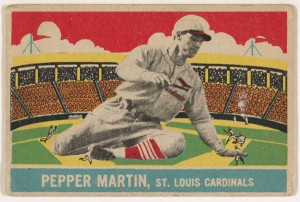Baseball at The Met
Friday, March 29th, 2019March 29, 2019
Yesterday, March 28, was the first fully scheduled day of the 2019 Major League Baseball season. As bats and balls connected across the United States and Canada, the Metropolitan Museum of Art in New York City celebrated the national pastime with a special exhibit: “Baseball at The Met.” The exhibit, which runs until August, features the enduring art and charm of nearly 140 years of baseball trading cards.

“Baseball at The Met” includes this baseball card of Pepper Martin, who played 13 seasons with the St. Louis Cardinals from 1928 to 1944. Credit: Pepper Martin, St. Louis Cardinals (1933), commercial lithograph from Delong Gum Company (Boston); The Jefferson R. Burdick Collection/Metropolitan Museum of Art
The main attraction of “Baseball at The Met” is the baseball card portion of the museum’s Jefferson R. Burdick Collection. Burdick (1900-1963), an electrician in Syracuse, New York, collected more than 300,000 pieces of popular art during his lifetime. Aside from baseball cards, Burdick saved advertisements, post cards, posters, and other forms of popular art. His collection is a significant part of The Met’s ephemera—things intended for temporary use that survive as collectable art—and it helps illustrate the history of popular printmaking in the United States.
Burdick donated his valuable collection of more than 30,000 baseball cards to The Met. The cards represent the most comprehensive public collection outside the National Baseball Hall of Fame in Cooperstown, New York. The Met’s exhibition highlights some 100 cards that date from baseball’s early days in the 1880′s to the “golden age” of the 1950′s. The cards depict baseball legends through illustration, lithography, photography, and early three-dimensional holography.

This uncut sheet of 1941 baseball cards, part of The Met’s Jefferson R. Burdick Collection, includes popular players of the era: “Eddie” Miller, Max West, “Bucky” Walters,”Duke” Derringer, “Buck” McCormick, Carl Hubbell, “The Horse” Danning, “Mel” Ott, “Pinky” May, “Arky” Vaughan, Debs Garms, “Jimmy” Brown. Credit: Uncut sheet from the Play Ball, Sports Hall of Fame series (1941), commercial lithograph from Gum, Inc. (Philadelphia); The Jefferson R. Burdick Collection/Metropolitan Museum of Art
The first baseball cards were intended for adults. They were used as advertising inserts—along with cards of actors, Civil War heroes, and politicians—by tobacco companies beginning in the 1880′s. The first chewing gum baseball cards aimed at kids did not appear until the Goudey Gum Company’s first series in 1933. By the 1950′s, kids across the United States were collecting baseball cards, and the hobby was nearly as popular as the game itself.
In 1951, Topps, the largest baseball card producer, introduced a 52-card deck of playing cards featuring baseball’s most popular players. The following year, Topps created a 407-card set sold in packets of five (ensuring tradable “doubles”), along with a semi-petrified stick of gum, for 5¢. Today, those penny cards can have astronomical value: a mint-condition (flawless) Mickey Mantle rookie card from that set sold for $2.9 million in 2018. (Mantle’s card is not the priciest on record, however. A 1909 card of Pirates great Honus Wagner sold for $3.12 million in 2016.) Like all collectibles, baseball cards have higher value if they are rare, and they must be in excellent condition.
In 1992, Topps dropped gum from the menu and concentrated solely on its lucrative market in baseball (and other sports) cards. Other major baseball card producers since the 1950′s have included Bowman, Donruss, Fleer, Panini, and Upper Deck. Beyond The Met, baseball cards are displayed in fans’ homes across the United States, and baseball card shows and conventions continue to be popular events.


